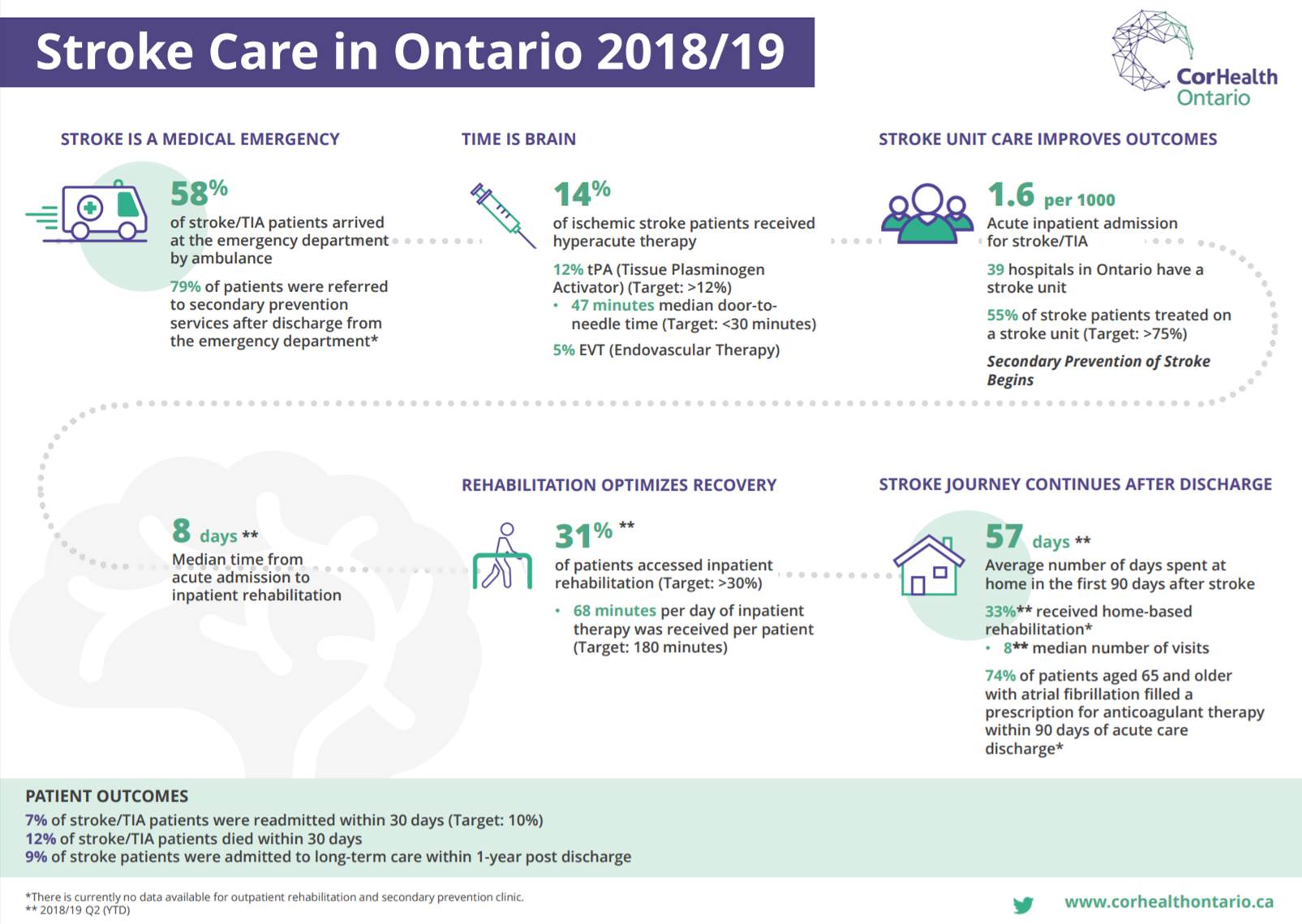Ontario Stroke Report 2018/19 Overview
Since 2011, annual stroke report cards and progress reports have informed system improvements, facilitated consistent planning across the province, and been a key resource for Ontario’s 11 regional stroke networks. Prior to this tenth stroke report, ICES, working with the Ontario Stroke Network (now CorHealth Ontario (CorHealth)), produced and disseminated the annual Stroke Report Cards and Progress Reports. CorHealth’s June 2018 Information and Digital Strategy set in motion a transfer of responsibility for the analytics to CorHealth. This transfer was intended to enhance internal expertise and technical understanding of the information for which CorHealth is responsible, and CorHealth’s capacity to support the information needs of cardiac, stroke and vascular health system stakeholders.
Thus, in 2017/18, all aspects of the annual Stroke Report, including oversight, production, and dissemination, was transferred to CorHealth. Since that time, CorHealth has established a methodological infrastructure and other resources, to support timely continuous improvement and refinement. ICES continues to play an important role as the provider and host of the clinical administrative and population data required to implement this report. The ICES iDAVE platform was used by CorHealth to implement most of the indicators in this report. CorHealth reviewed and, where necessary, clarified historical cohort methodologies with ICES. Where necessary, CorHealth has updated and/or enhanced these methodologies and technical documentation.
In the 2018/19 Ontario Stroke Report, a few key highlights from the report show that stroke patients’ access to hyperacute care has grown in the past few years. Most of this growth is attributed to the introduction and steady growth in access to endovascular therapy (EVT). There has also been growth in stroke patients accessing stroke unit care. Patients who receive stroke unit care are more likely to survive, return home and regain independence compared to patients who receive generalized care.1 Access to stroke unit care has also been found to influence access to other stroke best practices such as timely and appropriate stroke rehabilitation and applicable diagnostics such as carotid imaging.
An area for improvement, is in the rehabilitation sector. Many patients failed to receive the required rehabilitation therapy (intensity), receiving 68 minutes per day of direct therapy, well under the 180 minutes per day of direct therapy that is recommended in the Canadian Stroke Best Practices and adopted by Health Quality Ontario and the Ministry of Health and Long-Term Care, Quality Based Procedures Clinical Handbook for Stroke. There has been a decline in stroke patients accessing inpatient rehabilitation. Fully interpreting this trend requires understanding of capacity within the system for community-based stroke rehabilitation services. At the moment, there is no formalized data collection process to capture the number of stroke patients that access outpatient rehabilitation.
The annual Stroke Report acts as a foundation for knowledge exchange and quality improvement at a system and organizational level. CorHealth Ontario will continue to collaborate with Ontario’s 11 Regional Stroke Networks to align operating plans, knowledge translation approaches and implementation strategies to continue to advance best practice stroke care across the province.
2018/19 Stroke Care in Ontario Infographic
To capture key highlights from the report, CorHealth Ontario in collaboration with key stakeholders, has developed the Ontario 2018/19 Stroke Care in Ontario infographic. Please click here to view the infographic.
In addition to the infographic, the Stroke Regional Directors, have been provided with a comprehensive report that captures additional performance indicators for stakeholder engagement and quality improvement.
If you have any questions, please contact us at oh-corh_service@ontariohealth.ca.
1Boulanger, J., Lindsay, M., Gubitz, G., Smith, E., Stotts, G., Foley, N., … Butcher, K. (2018). Canadian Stroke Best Practice Recommendations for Acute Stroke Management: Prehospital, Emergency Department, and Acute Inpatient Stroke Care, 6th Edition, Update 2018. International Journal of Stroke, 13(9), 949–984. https://doi.org/10.1177/1747493018786616
This study made use of de-sensitized data from the ICES Data Repository, which is managed by the Institute for Clinical Evaluative Sciences with support from its funders and partners: Canada’s Strategy for Patient-Oriented Research (SPOR), the Ontario SPOR Support Unit, the Canadian Institutes of Health Research and the Government of Ontario. The opinions, results and conclusions reported are those of the authors. No endorsement by ICES or any of its funders or partners is intended or should be inferred. Parts of this material are based on data and information compiled and provided by CIHI. However, the analyses, conclusions, opinions and statements expressed herein are those of the author, and not necessarily those of CIHI.
The opinions, results and conclusions reported are those of CorHealth. No endorsement by ICES is intended or should be inferred.

